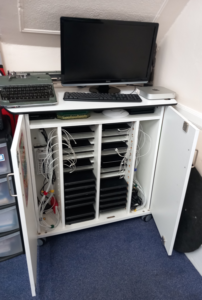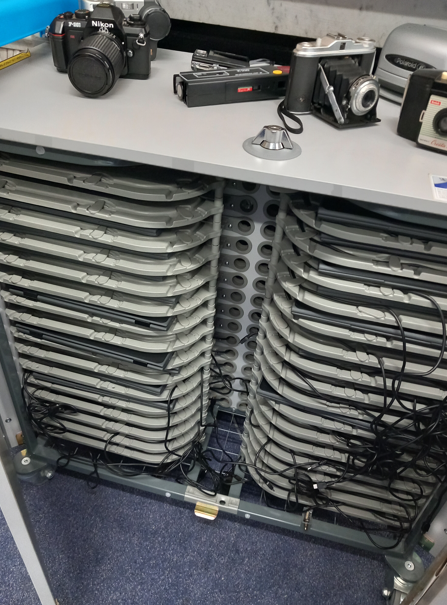We are seeing more and more laptop charging units within our schools and they are a fantastic tool to help teach and learn. However, have you given consideration as to where they are stored and charged? If you intend to store and charge large quantities of equipment containing lithium-ion batteries, we recommend carrying out a risk assessment on each laptop charging cabinet you have in your school to assess if the current location is the best place for it.
During visits for conducting Fire Risk Assessments at our maintained schools, our Fire Officers have seen stacks of lithium-ion battery devices piled on top of one another whilst on charge, or in cupboards:

Cabinets or charging trolleys are a convenient way to bulk charge devices and care must be taken, here are some simple rules:
Don’ts
- Don’t keep the charging unit under stairs or in an escape corridor.
- Don’t keep the units in a storage cupboard full of combustibles.
- Don’t block the vents on the sides of the units.
Do’s
- Keep the charging unit vents clear for obstruction.
- Store them in an open space.
- Put a process in place for reporting any damaged or dropped laptops.
- Ensure there is adequate fire detection in the location the units are stored.
Lithium-ion battery fires, which are the batteries in these kinds of devices are becoming more common every day as more and more devices contain them. This YouTube video shows examples of fires which have occurred in a range of devices from mobile phones to electric vehicles: https://youtu.be/8nz5ijXcckI?si=-y-zmCxaFQihNn88.
The primary cause of battery fires in products like phones and laptops is heat from being smothered in a bag or pocket or from heat generated while charging without proper battery temperature monitoring, which should be built in. One way to help prevent these battery fires is to use properly certified charging equipment as they are usually designed to charge at the correct rate and, depending on the product and charger, will usually have some sort of safety cut-off circuit if the device being charged does not have its own.
Another cause of lithium-ion battery fires is physical damage such as puncturing. If a device is damaged, for example dropped, and you cannot trust your own judgement as to whether the battery was compromised they should be taken out of use and repaired or replaced by your supplier.
If a lithium-ion battery fire begins, get out of the building. Lithium-ion battery fires are self-oxidizing which means that they can re-ignite, even after they appear to have gone out. The best thing you can do in the event of a lithium-ion battery fire is simply get away from it and call the emergency services.
Regardless of steps you take to try and mitigate these fires, you should never leave a device containing a lithium-ion battery to charge unattended.
If you need any support, guidance or have any questions following your Fire Risk Assessment please contact the fire safety team, where they will be happy to help, and can be emailed: scfiresafety@somerset.gov.uk
Learn more:
Fire Guidance
Batteries don’t belong in bins
What Is Thermal Runaway?

